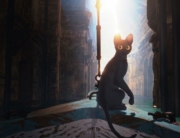On Christmas Eve, 1985, two veterinarian students broke into Mexico’s National Museum of Anthropology, stealing more than 100 pieces that constitute part of the country’s archeological heritage. It was called the “robbery of the century” by the Mexican press and was considered one of the biggest museum heists in history. (The pieces were recovered four years later.) This implausible historical anecdote is perfect movie material for the second feature film by Alonso Ruizpalacios (Güeros). His adaptation changes characters names but retains the essence of historical facts. One epigraph remarks, “this story is a replica of original.”
Juan Nuñez (Gael García Bernal) and Benjamin Wilson (Leonardo Ortizgris) are in their 30s and haven’t yet completed their veterinarian studies and are still living with their parents. Juan is the laughing stock at family reunions, while Benjamin takes care of his terminally ill father. On Christmas Eve, they decide to immediately execute the museum heist, which apparently has been planned months before.
For the two amateur thieves, the burglary is a complete success, and the long robbery sequence is crafted with tension and realism. Juan and Benjamin take their time to extract all the pieces with almost surgical precision. One of the steps involves the softening of glass sealer with chemicals and slowly rising heat. The smoke surrounds the robbers, who wait patiently for the perfect instant to lift the protective glass and grab the artifact. This is not a glamorized Hollywood heist movie, but a very entertaining one because of its methodical, realistic approach. This is the kind of scheme that any regular guy could try, and that’s why their triumph is even more fascinating.
If it wasn’t based on a true story, it would be easy to point out that the plot is implausible. Ruizpalacios amusingly contrasts what the media reports (a more complex operation executed by a gang with “foreign” links) and the silly simplicity of what really happened. The script never loses a chance to underline the irony—the empty showcases at the museum attract more visitors than ever. And when Juan and Benjamin are retained by a guard at a check point, the officer seems indifferent to the “handicrafts,” as Juan describes them, hidden inside the duo’s backpacks. However, Juan and Benjamin discover that selling those pieces will be more complicated than they initially thought.
Museo moves gracefully between satire and history while dipping into different subgenres, morphing from a family drama to a heist film to a buddy road trip, with a touch of mysticism thrown in, but it is mostly centered in the emotionally invested drama of Juan and Benjamin’s friendship. García Bernal has mega movie-star status in Mexico, and perhaps his talent is taken for granted. With a stoic expression and repressing emotions, his rendition here is exceptional.
Benjamin, the narrator, warns viewers repeatedly that we never know why people do what they do and that we cannot talk on their behalf. The screenplay, written by Ruizpalacios and Manuel Alcalá, never tries to explain why two middle-class young men take risks in such an extreme way or to justify their actions. What the story advocates instead is the idea of plundering as an unavoidable and maybe necessary action to preserve the legacy of a culture and rescue it from oblivion. Along the way, Museo playfully asserts a paradox of art: it can be invaluable and (in some context) worthless at the same time.







Leave A Comment